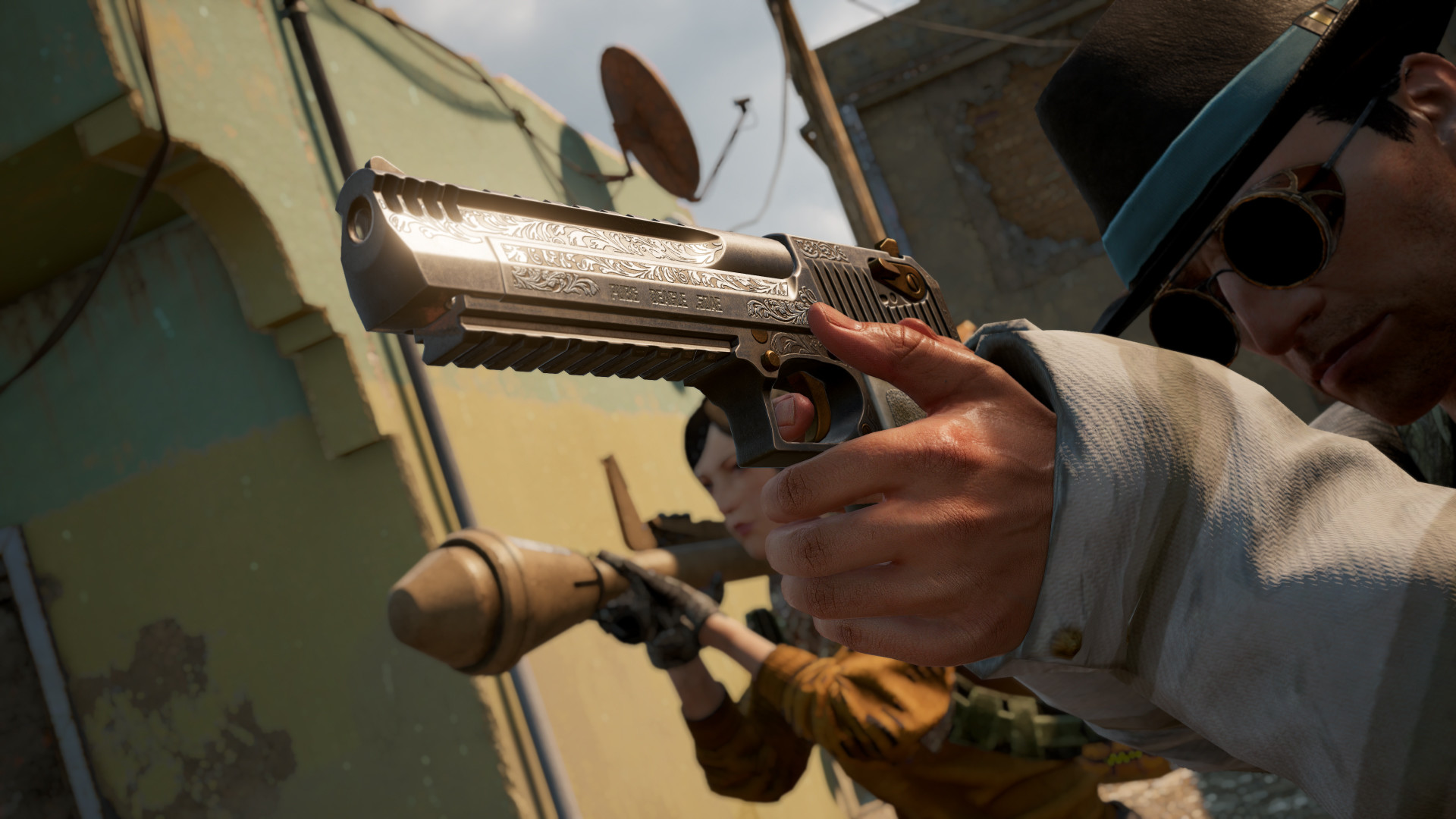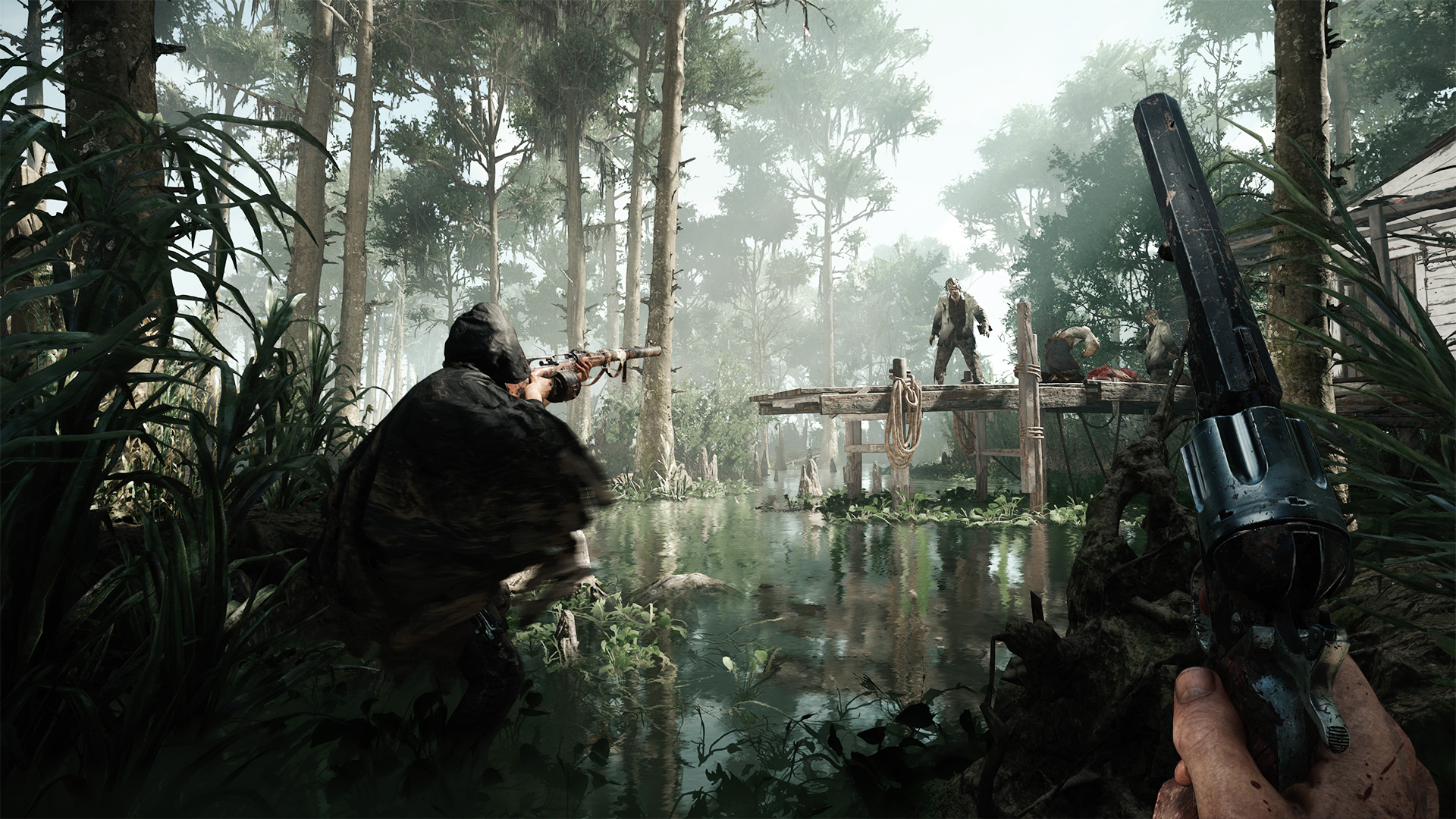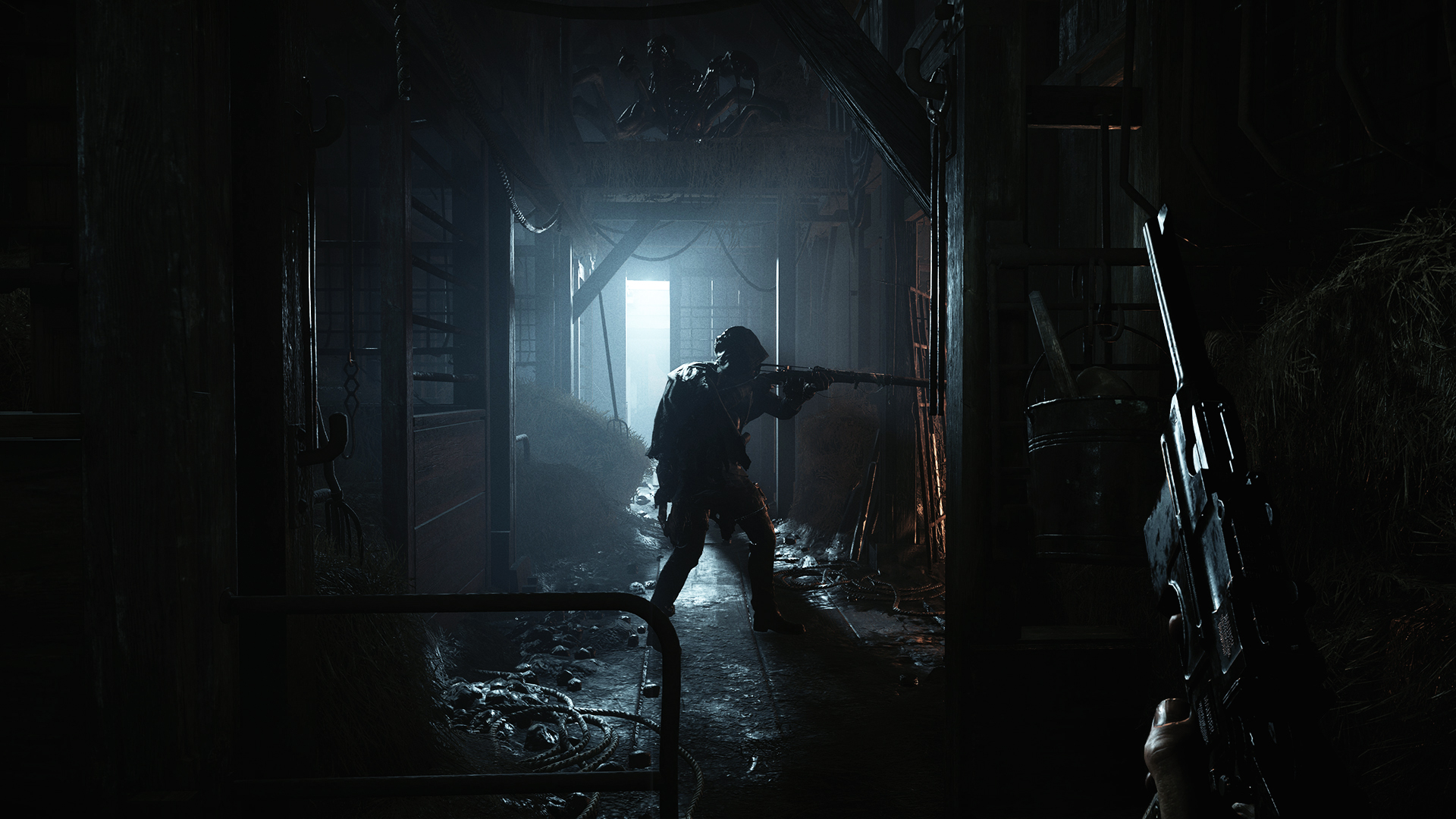“Essentially it’s poker, right?” says Brendan Greene. “You all start with the same deck, and it’s the decisions you make that get you to the end. I didn’t invent the idea of last man standing.” But what he did invent was arguably the most influential game of the past five years. Greene is better known by a different name: PlayerUnknown, and it’s his Battlegrounds that ignited the battle royale craze.
PlayerUnknown’s Battlegrounds first launched into Steam Early Access on March 23, 2017. It dropped 100 players from a plane onto an island and asked them to kill each other while they scrambled to stay in a shrinking play zone. Developers still lean on PUBG’s pillars today. Fortnite, Apex Legends, and Call of Duty: Warzone—which along with PUBG make up the big four of the genre—have iterated on Greene’s work rather than re-invented it. Fortnite added complex building mechanics to let players conjure cover from thin air, Apex Legends emphasized teamwork with a voice-less ‘ping’ communication system, while Call of Duty: Warzone sends players to a 1v1 gunfight after they die, giving them a chance to respawn.
Videos by VICE
Along the way, many other games have jumped on and quickly fallen off the battle royale bandwagon. But the recent success of Warzone, which amassed 50 million players in its first month, shows battle royale still has plenty of pulling power. Where does Greene think the genre is heading? And does the past three years give us any clues?

You can trace the idea of a last man standing deathmatch to Koushun Takami’s 1999 novel Battle Royale, adapted into a film of the same name the following year. In the book, a fictional authoritarian government kidnaps high school students, drops them in a remote location, and forces them to fight each other to the death. If you’ve read or watched The Hunger Games, the premise will sound familiar, although author Suzanne Collins said she wasn’t aware of Takami’s work until she’d finished her first draft.
The concept jumped to gaming soon after The Hunger Games hit cinemas in 2012. Minecraft servers started hosting Hunger Games matches, later called Survivor Games, in 2012. Let’s play community Mindcrack, a network of popular Minecraft YouTubers, soon ran their Ultra Hardcore (UHC) series of PvP deathmatches between popular Minecraft YouTubers, and DayZ, which started as an Arma 2 mod, launched Survivor GameZ (SGZ), where streamers paired up and battled 15 other teams on a large map. Greene, who grew up on an army base in County Kildare, Ireland, loved DayZ but couldn’t compete in SGZ because he wasn’t a streamer, so he vowed to create a version that was open to all.
His DayZ: Battle Royale mod was born. It started with players grouped together just like in The Hunger Games, grabbing loot from a pile of backpacks before fanning out. But when Greene began working on the Arma 3 version of the mod, he introduced the plane that dropped competitors across a large map, ensuring a more even spread of action. “[Streamer] Lirik was playing it for nearly a year on and off. He was always like: ‘One more game, one more game’. I thought, okay, I have something here.”

The mod’s success got Greene hired as a consultant for H1Z1, where he created the battle royale game mode H1Z1: King of the Kill, which span off as its own game, and later, Bluehole offered him the chance to control his own project.
“PUBG was that sort of final realisation [of my vision], after three years of working and maybe thinking that I would never get a chance to make it,” he said.
It was released through Steam Early Access in March 2017, and kept smashing the platform’s player count records. In December 2017, following its exit from Early Access, it surpassed three million concurrent players on Steam. The previous player count record was 1.3 million, held by Valve’s MOBA giant DOTA 2.
“I thought maybe we’d approach, you know, CS:GO numbers,” Greene said. “The numbers we achieved, god, it blew us all away. Our server infrastructure was set up for a million concurrent users because that’s how much we thought we’d never get, right? That was like DOTA plus 30 percent. There was no way you were getting that.”
Greene attributes the early success of PUBG—and the attraction of battle royale as a whole—to, first, the pacing, with downtime punctuated by bursts of action. And second, to matches being completely fair. Every round has random loot and circle spawns, but the random number generator averages out over time, putting everyone in the same boat.
“I don’t know if I discovered a formula—all I wanted was just to be fair,” he told me. “ You always wanted every game to be different because that’s the fairest way to test the player: are you good in every situation, instead of just there’s one situation you’re very familiar with? It’s just a game of decisions, and if you play your cards right, you have a chance. I think that’s what draws people into PUBG still.”

Soon, developers proved battle royale could work at a faster pace. Fortnite, with its smaller map, cartoonish art style and twitchy building controls, quickly became the battle royale of choice for younger audiences. Perhaps more importantly, it was free, and quickly became available on all platforms. Fortnite passed PUBG for player count in February 2018 and kept climbing, becoming part of mainstream culture: in March 2018, streamer Ninja played with rapper Drake to an audience of nearly 700,000 people. The biggest names in FPS development wanted a slice. Battlefield 5 launched with Firestorm, and Call of Duty: Black Ops 4 with Blackout, which drew healthy numbers, but nobody could topple Fortnite or PUBG until Respawn Entertainment, with very little warning, released Apex Legends in early 2019. “Like any new genre, everyone will try to jump on… [but] Apex brought a lot more verticality and speed and movement, it really was a different spin on it,” Greene said
Warzone has done the same in 2020. Aside from the 1v1 gunfights in the Gulag, it differentiates itself through contracts spread across the map. Completing a contract – either assassinating a specific target, finding a series of chests or defending a given area – nets you cash to spend on loadouts for the late game.
Greene said it’s humbling that “this small idea I had to pit players against each other has turned into essentially a game mode. It’s now being included in all these titles as what looks to be on a yearly basis. I think it looks like Call of Duty will probably have a battle royale type game in their titles for the coming years, which I never expected. I’m very grateful that people still enjoy it.”

And he’s convinced that the core concept is flexible enough for developers to squeeze more juice from it. “I think there’s a lot of hungry devs out there that want to try their own spin on it. It’s just something that works really well if you can manage to lock down a nice loot system and a simple end game,” he said. History is a goldmine of potential settings: “There’s a Vietnam battle royale… a space battle royale with no gravity. Why not?”
The biggest battle royale games will be around “for years to come,” he said, and new games could struggle—unless they have genuinely fresh ideas. For that reason, Greene encourages developers to focus on what they want to play themselves, rather than making a battle royale for the sake of it. “You might be lucky and someone else might want to play it too,” he said.
We’re also seeing the lines between battle royale and other genres blur, and that’s likely to happen more over the coming years. Escape from Tarkov drops groups into a large map with no respawning, but ditches the last man standing victory condition. Players can succeed without getting a single kill if they find the right loot and make it out alive, with progress persisting between sessions. The same is true for Crytek’s Hunt: Showdown. A group of hunters search a medium-sized map for a monster, kill it, and try to escape with the bounty. Players can also hunt each other, stealing bounties. It’s not a battle royale, but if you’re the last one alive, you’ll be the one extracting with the cash.

Hunt lead designer Dennis Schwarz said is “related to the same parents” as battle royale games, and that it is heavily influenced by DayZ. But where PUBG forces you to engage if you want to win, firefights are merely an option in Hunt. “You see that idea of the royale being more than just free-for-all last man standing,” he said.
Producer Fatih Özbayram said the battle royale genre has become more social over the past three years: you can still play solo, but options for duos, trios or squads of four mean you can play with groups of friends of different sizes. He said Apex Legends’ ping system was a huge step forward in letting players communicate, and the trend for more social features will continue, he said. He also predicts battle royale games will have more side objectives in future, giving players more ways to contribute without racking up kills.
Schwarz agrees. “There’s a chance for you to feel like you also contributed, you had some success moments, even if you didn’t have a chance to make it to the end game. There’s a measure of progress…. I think that’s a very important aspect.”
Given Warzone’s success, it’s not outlandish to suggest these side objectives, perhaps PvE in the style Hunt: Showdown, could become a genre mainstay, giving a measure of achievement that goes beyond unlocking a new weapon skin.

How the genre evolves could be as much about tech as it is design. Hunt’s scaled-down maps have only 12 players, allowing for detailed worlds and lots of AI enemies. “You cannot have mobs running around and 100 players, it’s just very, very unfeasible,” Özbayram said. The way gaming habits change will also be crucial. If players, especially younger fans, trend towards playing games in short sessions, battle royale games will likely shrink in scale. Conversely, we might find that over the next five years, more players are willing to spend an hour in a single session, allowing for battle royales of larger scope.
Özbayram said battle royale games are going nowhere, but said it’s clear developers will have to adapt.
“Maybe it’s not going to be last man standing anymore. Maybe it’s more like Hunt where you have side objectives as well, where you don’t always feel like a loser after a session. I don’t think it will disappear, it will most likely grow and evolve to something different.” Schwarz said the genre has matured to the point you have a “royale for every taste these days”, and developers can keep making variations for at least a few more years. Then, “probably the next big thing comes along, maybe even as an offspring from [the genre], and something completely new generates”.
What might that look like? Greene is clear that the push to make battle royale an esport will continue—the genre is still young and a proper esports scene could be years away, he said. On that point, he’d like to see developers working together and sharing best practices.
Greene’s currently working on Prologue, a project that’s still shrouded in mystery. He won’t confirm anything about his plans—he told me the last man standing concept “has such a wide variety of applications, but that’s not the way I’m thinking about it right now. We’re developing some tech internally, and then I have to think of games upon that tech”. He hinted at a “very big goal”, and speaks of his excitement at Unity’s Megacity project, which generates a whole metropolis. “Everyone wants to build the oasis. Everyone’s like, yes, we want to make the big world, the online space everyone can interact with.”
He’d like to see a “life game mode” similar to GTA Online in PUBG’s Erangel map at some stage, he said, and believes that could happen by giving players tools to build their own projects, which will be a major focus for PUBG Corporation’s development team this year. He likens PUBG to a sandbox, and said: “If you put in the tools, it will just happen. That’s what I’m taking from battle royale into my other games – I want to find ways to leverage that. You don’t want to give people a game, you want to give people a world, and if you give people a world, they’ll make their own games.”
Whether that’s a GTA Online equivalent for PUBG or something else entirely remains to be seen. But it’s clear Greene believes giving players more power over the battle royale genre is the best route forward. “That’s where the next PUBG will come from, the next PlayerUnknown will come from, it’s from a mod,” he said. “Players will tell their friends [about that mod], like they did with battle royale. And then, you’re at the helm of a new genre.”
More
From VICE
-

Screenshot: Konami -

Photo by Neil Lupin/Redferns -

Screenshot: Epic Games -

Screenshots: Bethesda Softworks
